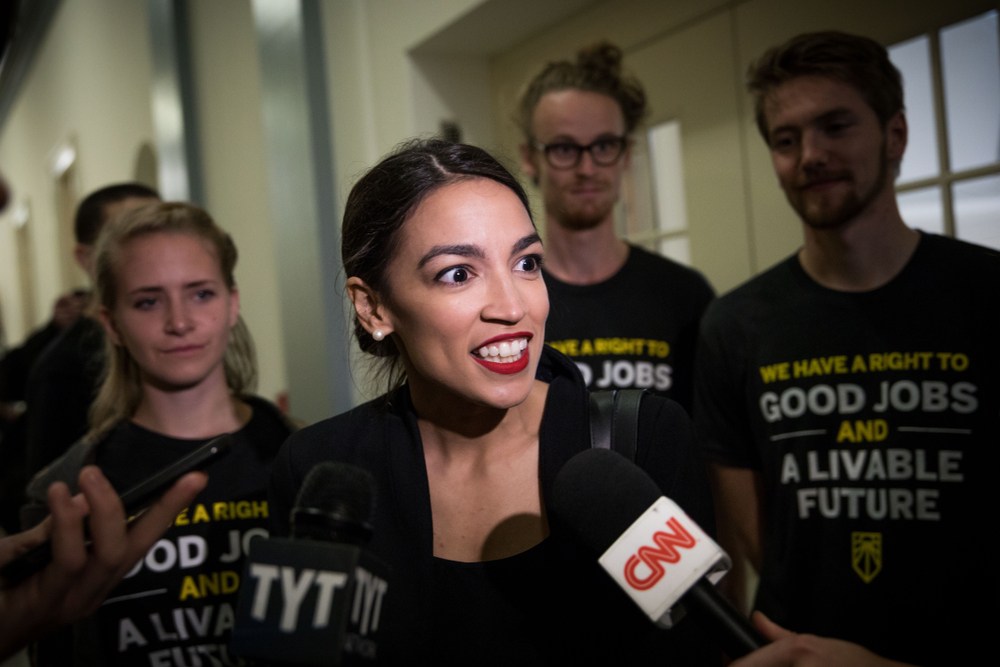by John Feffer
It’s become a common trope of the Trump era for columnists and commentators to attack the lunacy of the far right at the same time as castigating the “loony left.”
These pundits, who usually place themselves in a comfortable “moderate” position, adopt a tone of consummate reasonableness. The president is certainly an idiot, they say, but it would be a mistake to respond with comparable insanity from the other side of the political spectrum.
Much of this pox-on-both-houses commentary focuses its criticism on individuals: Rep. Alexandria Ocasio-Cortez (for being naïve), Rep. Ilhan Omar (for being anti-Semitic), Sen. Elizabeth Warren (for being fast and loose with the facts of her own background), Sen. Bernie Sanders (for being, well, Bernie).
These ad hominem attacks are irritating, but the false even-handedness has been especially disturbing at the level of policy. For instance, the so-called moderates let loose a volley against Trump’s power move to declare a national emergency in order to build his wall along the U.S.-Mexico border. Then they turn around and blast the progressive vision of a Green New Deal (GND). On the very same opinions page of The Washington Post last week, Max Boot called the GND the “left-wing version of Trump’s farcical promise that he would build a border wall and make Mexico pay for it,” while George Will opined that “President Trump has his wall, the left has its GND.”
Really? Really?!
Okay, I have my own laundry list of ridiculous positions that elements of the American left have taken over the years. But addressing climate change and economic inequality should absolutely be at the very center of any sensible, reasonable political program — left, right, or center. The first is an existential threat to the human race that requires an urgent response in the next dozen years or it’s basically game over for future generations. The second is an endemic problem that, in addition to causing much abject misery, has contributed to political polarization, the rise of dangerous right-wing populism, and the fraying of multilateral institutions.
And Max Boot and George Will compare the Democratic Party’s effort to address these major crises to Donald Trump’s ridiculous “solution” to a threat of his own creation? Talk about false equivalences.
And it’s not just Will and Boot (which, by the way, would make a great name for a right-wing sitcom). In The Washington Post alone, Roger Lowenstein criticizes the GND for being too socialist, Charles Lane argues that the GND cannot be democratic because FDR’s New Deal required a good deal of coercion, David von Drehle lambastes the GND as unrealistic and hyperbolic, Catherine Rampell calls it “lazy sloganeering,” and Megan McArdle piles on with her assessment that it’s “lunatic.”
Ah, the liberal-conservative echo chamber!
This is the mainstream media, mind you, not the Fox News–Daily Caller–Limbaugh axis of inanity. True, there have been a few dissenting voices who have praised the Green New Deal: Eugene Robinson in The Post, Liam Denning at Bloomberg, Al Gore on his own website. But the GND has emerged as the perfect opportunity for anyone who aspires to cultivate what passes for political credibility inside the Beltway to balance their anti-Trump jeremiads with a swipe at the left.
Let’s take a closer look at the GND proposals to see if they are as wildly off base as the Washington consensus suggests.
Reading the GND
The House resolution introduced by Rep. Ocasio-Cortez begins with a summary of the latest report from the Intergovernmental Panel on Climate Change, released last October. It’s a grim recitation of the costs — physical as well as financial — to the planet if global temperatures rise 1.5 degrees Celsius over pre-industrial levels.
Then the resolution identifies the economic problems afflicting the United States, from four decades of stagnation to the kind of income inequality not seen in 100 years. It briefly connects the two issues: climate change will, for instance, disproportionately affect the poor since the rich can use their money to cushion the effects. It then cites the example of the New Deal as an ambitious program to put Americans at work to rebuild the country.
Finally, it identifies the goals of the Green New Deal: to achieve net-zero greenhouse gas emissions by employing a large number of Americans to transform the infrastructure of the country and to do so in a just and equitable manner. This would require a 10-year national mobilization that builds up the capacity of renewable energy sources, makes buildings more energy-efficient, transforms manufacturing along sustainable lines, reduces carbon emissions from the agricultural sector, and expands clean and affordable public transportation. At the same time, the mobilization would be eco-friendly by cleaning up hazardous waste sites and restoring biodiverse areas.
In terms of addressing economic inequality, the GND calls for more funds for education and training in “frontline and vulnerable communities” along with focused job creation in those communities and fair-trade practices that encourage the growth of domestic manufacturing.
This is a nonbinding resolution. It doesn’t come with any budget requirements. It doesn’t create any agencies.
Critics dismiss it as a dream. But that’s precisely what it is. It’s visionary.
Hillary Clinton came under attack — from some of these same “moderate” pundits — for being too wonky, for not articulating a bold and transformative vision for the country.
Well, here it is folks, something that candidates for offices at all levels can hold up and say, “We’ve stuck to the status quo for years and that’s why we’re in this crisis. Americans voted for Trump because they wanted something new but they only got more of the same: corruption, lies, tax cuts for the wealthy. So, now here’s something new and big and bold. This is how American can lead. This is how we can help ourselves, our neighbors, our country, and the world.”
Go big or go home, America.
Answering the Critics
Much of the controversy surrounding the Green New Deal has nothing to do with the resolution itself. Conservatives in particular have focused on a “fact sheet” distributed to the press by Ocasio-Cortez’s office. They have quoted from this document to argue that Democrats want to get rid of cows, take away your car, and give money to people who don’t want to work.
The fact sheet clearly did not receive as much care and attention as the resolution itself. After a firestorm of criticism, Ocasio-Cortez’s office amended the document.
The rollout of the GND was reminiscent of the controversy surrounding the rollout of Obama’s health care initiative, when the website Healthcare.gov crashed on its first day. Yes, the administration should have handled the rollout more effectively — but the Affordable Care Act proved to be extraordinarily popular and effective (at least, until certain states and then the Trump administration began to take an ax to it).
Some speed bumps are to be expected with big initiatives like universal health care or a Green New Deal. Frankly, it’s amazing that a newly elected representative has managed to pull together so much support within the Democratic Party for such a proposal. Let’s not get worked up over a few poorly chosen words in a fact sheet.
Still, some of the criticisms merit discussion because they help clarify the issues.
The major challenge for a proposal of this nature is how to pay for it. Here the critics complain that GND supporters want to just print money to pay for the program, that it will throw the country into deeper debt, that it will cause hyperinflation, that it will turn the United States into Venezuela.
Dealing with climate change is going to cost a lot of money. It will be equally costly to address economic inequality.
But the proponents of GND are far more fiscally responsible than either the George W. Bush or Donald Trump administrations, both of which combined tax cuts with increases in military spending. The Global New Deal is about marshalling both public and private resources to grow the economy. This is not welfare-state redistribution. This is expanding clean industries, creating jobs in sectors like retrofitting existing housing, and investing in new technologies that can make the United States more globally competitive.
Meanwhile, the costs of the current haphazard way of addressing climate change are mounting: a half a trillion dollars in lost economic output by 2100 plus another trillion dollars in damage to public infrastructure and coastline, according to the U.S. government’s own accounting in November 2018. Those are the minimum opportunity costs of continuing on the current path.
Critics argue that leaving nuclear power out of the equation makes it impossible to meet the goals of reducing carbon emissions. This is definitely an important debate. And it will no doubt be difficult for America to wean itself off nuclear power, which currently supplies about 20 percent of overall electricity generation.
But in 2000, nuclear power supplied Germany with nearly 30 percent of its electricity. Today it’s down to 13 percent, and the country plans to zero out nuclear power by 2022. Furthermore, it is doing so as part of a more ambitious plan to reduce greenhouse gases than the United States has undertaken (though Germany will also likely fail to reach those goals in 2020 for reasons having little to do with nuclear power).
Critics also note the lack of a central role in the Green New Deal of either a carbon tax or a cap-and-trade system. The fact sheet acknowledges the utility of both of these tools. But it rightly points out that these market mechanisms are woefully insufficient given the scale of the problem.
Will GND get rid of cows and cars? No.
Methane-producing cows are certainly a problem. Livestock produce more than one-quarter of U.S. methane emissions (which are far worse for climate change than carbon dioxide). It behooves us all to move toward a more plant-based diet for a variety of reasons, including climate change. But in the meantime, it makes more sense to talk about changing what cows eat — for instance, adding seaweed to their diet — than getting rid of them altogether.
The same can be said about cars — their diet, too, should shift, in this case from gas to electric. But America’s obsession with cars must also change. Beefing up public transportation makes eminent sense. Even replacing planes with high-speed rail is an appealing option for much of the country. The fact that California hasn’t been able to get its one proposed high-speed line up and running has nothing to do with the wisdom of the plan.
Compared to Asia and Europe, the United States is a transportation embarrassment. At minimum, Americans should not be flying between destinations on the East Coast or within California when rail would be much more energy efficient.
Time Running Out
Alexandria Ocasio-Cortez is doing the right thing. She’s not waiting around to get more experience of the legislative playing field before launching a major initiative. She’s keeping her eye on the essential issues even as her critics carp about a few miscues. As the youngest representative in Congress, she represents the hopes and frustrations of the next generation. Young people around the world are staging school strikes and launching lawsuits to protest the lack of action from their supposedly wiser elders.
In my new novel Frostlands, the main character, glaciologist Rachel Leopold, tries to explain to a group of schoolchildren in the year 2051 why her generation failed to solve the problem of climate change. She tells the story in the form of a fairy tale featuring a terrible monster.
“What did the monster look like?” the children ask.
“It was invisible, my dear children,” I reply. “But we could feel its hot breath and see the terrible things it did. It could make the oceans rise. It could make the crops wilt in the fields. Still, we kept feeding this terrible beast.”
“But why?”
“It’s what the monster demanded. Some monsters want to devour little children. Others insist on young maidens. But this monster demanded tankers of oil and truckloads of coal. Even as it grew, it demanded more and more.”
The children are wide-eyed by now. “What did you do?”
Rachel tells them about the testimony she gave before Congress. But the legislators didn’t listen. So, Rachel gave up.
The children look disappointed. They know their fairy tales. They expect someone — a knight in shining armor, an orphan child with special powers — to appear suddenly and slay the monster.
“There was no knight,” I lament. “The monster still lives. We can feel its hot breath even today.”
“It’s not fair,” complains a little boy. “You should have killed it.”
“Why didn’t our grandparents run the factories every other day?” a bright young girl pipes up. “Why didn’t they drive those stupid cars just on the weekend?”
Why indeed.
But now it seems that someone in Congress is listening. The Green New Deal is America’s last best chance to get it right.
Otherwise, dystopia beckons…






This is an incredible article. Ignorance abounds in the sentences above.
At least it was not passed off as a news story.
Thank you John Feffer for your excellent article! Please keep up the good work.